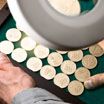Production technologies
Materials, decorations, finishing, tools
Mennica Polska is one of the most technologically advanced mints in the world.
Thanks to ambitious projects and fresh approach towards their realization, sophisticated technologies and commitment of our staff, our products are in constant demand.
Advanced projects
In order to create outstanding commemorative coins, Mennica Polska focuses on innovation. In February 2015, the Company introduced its remarkable souvenir coin “Seven New Wonders of the World” – the first spherical coin minted with unprecedented attention to detail. Based on the beautiful hand-drawn XVII-century map created by the eminent Dutch cartographer Willem Janszoon Blaeu, this ravishing masterpiece of monetary art combines past and present in its extraordinary design and shape – the Seven New Wonders of the World are marked on the historical map with elegant SWAROVSKI ELEMENTS.
The spherical coin is not the first product of innovation struck at Mennica Polska. In recent years the Company presented a 3D-coin in the form of a pyramid, and one – issued on the occasion of the canonization of John Paul II – in the form of a cube.
„Mennica Polska continues its nearly 250-year-old tradition. Yet, our brand is considered a token of innovation. Thanks to ambitious projects and unclichéd approach towards their realization, high-end technologies and highest craftsmanship, our products are pioneers in the field of numismatics."
– Grzegorz Zambrzycki, the President and CEO of Mennica Polska.
Overcoming the barriers
The portfolio of Mennica Polska is very diverse. An impressive 10-kg silver coin “Pro Memoria” commemorated the 10th anniversary of the death of John Paul II. Considerable size of this memento reflects the historical importance of longtime pontificate of the Holy Father.
The coin was minted with four strikes of the minting press, with pressure of up to 2500 tons!
It was a challenge to preserve its proof surface due to exceptionally large diameter and weight of the token. However, Warsaw minters, well-known for their exquisite craftsmanship, managed to achieve this ambitious goal. The result of their work was impressive.
Thanks to the highest purity of silver, impressive diameter of 210 mm and face value of 1500 New Zealand dollars, this exclusive souvenir was highly praised by most demanding collectors. Very low mintage – only 10 pcs – confirmed its uniqueness.
Decorations
Finishing and decorations play a vital role in the designs of commemorative coins. Digital printing hardened with UV light is an important technique used to enhance the visual quality of a coin.
Thanks to this method the images imprinted on the coin’s surface are vivid and realistic as they stand out with high hue saturation and resolution.
Digital printing opens a wide range of finishing techniques used by Mennica Polska. Among commonly used decorative elements one can find here a variety of inserts – precious stones, diamonds, synthetic crystals (e.g. SWAROVSKI ELEMENTS) and ambers. In 2012, Mennica Polska used an amber insert to create an original souvenir coin “Amber Room” from the series “Mysteries of History”.
Surface
Latent image effect is one of the most intriguing decorative techniques applied on coins. If you tilt the coin to a certain position in the light, you will see a latent image. Depending on the angle, one can see up to four different signs.
An outstanding example of implementing this means of decoration in Mennica Polska was the coin “Warsaw University of Technology – 100 Years of Revival”. Latent image effect on its obverse depicts Greek letter Sigma (Σ)/gearwheel/division times sign (⋇).
Glass inserts are yet another technique used for decorating commemorative coins in Mennica Polska. One of them – “400 Years of Polish Settlement in North America”, was embellished with a hand-painted glass insert.
In 2010, during the XXVI Conference of Mint Directors in Australia, this outstanding souvenir was acclaimed “the most technologically advanced silver commemorative coin”.
It is worth mentioning that various types of decorations are applied not exclusively on the coin’s obverse or reverse. The series of commemorative coins “Treasures of King Stanisław August” issued by the National Bank of Poland serves as a perfect example of how inscriptions etched onto the coin’s rim can enhance its artistic value. The series consists of copies of commemorative medals struck during the reign of Stanisław August Poniatowski.
To please the eye
The use of microprinting can produce outstanding visual effects. The coin “Jan Karski – 100th Anniversary of Birth” issued by the National Bank of Poland serves as a perfect example that microprinting can be used as dominant decorative element of an original and beautiful design.
Selective gilding is a subtle decorative technique applied on silver commemorative coins. In 2014, a souvenir coin embellished with selective gilding – “Year of the Horse” from the “Chinese Calendar” series – won 1st place in the category “most technologically advanced silver coin of a weight under 5 ounces” during the XXVIII Conference of Mint Directors in Mexico.
Souvenir coins can be struck in a combination of several alloys. The already mentioned gold coin “Warsaw University of Technology – 100 Years of Revival” was minted in three types of tinted gold: white, rose and yellow.
This technique is used to create most prestigious and luxurious products.
Transparent capsules containing silver filigree inserts covered with 24-carat gold are an innovative way of embellishing commemorative coins. This technique was first used in the designs of “Lucky Coins”.
When we think of a coin, we usually imagine a shiny flat round object. We have already mentioned 3D coins in the form of a cylinder, pyramid and sphere. In fact, non-standard shapes are nothing unusual in the case of commemorative products.
In Mennica Polska we have already manufactured numerous coins with interesting shapes: Christmas coin in the shape of a bell and one in the shape of a Christmas tree.
Also, there are Valentine’s Day coins in the shape of a heart and puzzle-shaped coins, as well as square and rectangular ones.
More and more often we design coins that can be worn as jewelry. In our portfolio one can choose among coin pendants and bracelets.
See also


